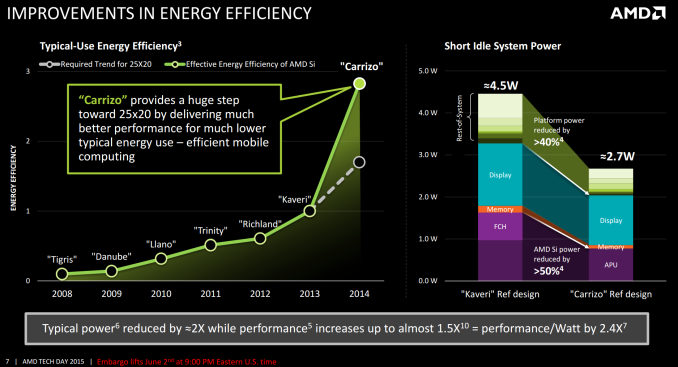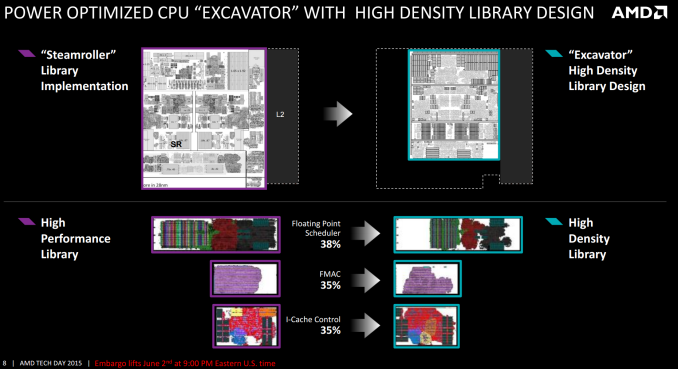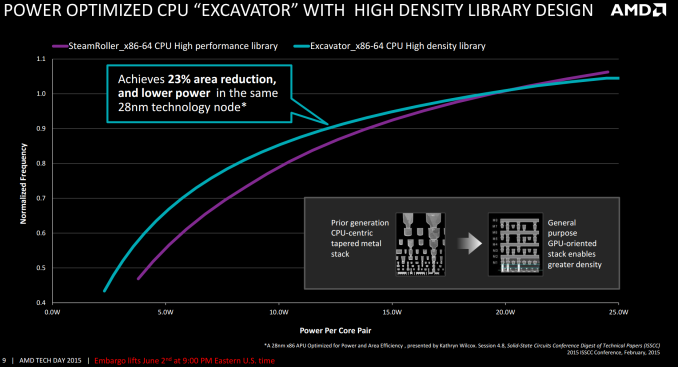AMD Launches Carrizo: The Laptop Leap of Efficiency and Architecture Updates
by Ian Cutress on June 2, 2015 9:00 PM ESTEfficiency and Die Area Savings
AMD’s take home message in all of this is efficiency. We a being quoted a performance per watt increase of 2.4x, coming from typical power draw savings of 2x and performance increase of almost 1.5x for 23% less die area, all in one go.
Ultimately this all helps AMD’s plan to be 25x more efficient with their APUs by 2020, and the cumulative bar chart on the right is how mobile improvements from all sides are being realized. Migrating the southbridge on die severely reduces its idle power consumption to almost zero and can help efficiencies elsewhere in the system. The APU general use and memory controllers are the next targets, but the common constant here is the display. Using a low power display might give battery life in exchange for quality, and there is only so much power you can save at the SoC level. In time, the display will be the main focus of power saving for these devices.
A big part of the reduction in die area comes from the set of high density libraries being used by AMD. Above were three examples provided where >33% gains were made in silicon area. Typically using a high density library design is a double edged sword – it reduces die area and potentially leaves more area for other things, but the caveat is that it may be more prone to defects in construction, require additional latency or have a different frequency/voltage profile. AMD assures us that these changes are at least like-for-like but most of them contain other improvements as well.
It’s worth noting here that AMD has described the high density library project internally as the equivalent of a moonshot, essentially the developers were part of a ‘skunkworks’ division attempting to make drastic changes in order to improve performance. The high density library is one such successful project from that.
With the new libraries, comparing Excavator to Steamroller shows the effect moving designs has. The power/frequency curve below 20W per module shifts to higher frequency/lower power, whereas losses are observed above 20W. However for 15W per module, this means either a 10%+ power reduction at the same frequency or a 5% increase in frequency for the same power. Should AMD release dual thread / single core APUs in the 7.5W region, this is where most of the gains are (as noted in the comments, the dual module designs are at 7.5W per module, meaning that what we should see in devices is already in the peak value for gains and benefits such as 25% frequency or 33% power). As also seen in the insert, the silicon stack has been adjusted to a more general purpose orientation. I could comment that this makes the CPU and GPU work better together, but I have no way of verifying this. AMD states the change in the silicon stack makes production slightly easier but also helps with achieving the higher density Excavator exhibits.













137 Comments
View All Comments
SilthDraeth - Tuesday, June 2, 2015 - link
It is sad that AMD struggles so much. I bought an HP with 1366x768, ie budget screen on most retail laptops, and an AMD A10-4600 and it plays games like Dirt 3, and stuff just fine. I haven't installed a ton of games on it. But it certainly out performs any mobile i5 or i7 that didn't have dedicated graphics card.I really hope Carrizo kicks off, and finally AMD gets some love.
meacupla - Tuesday, June 2, 2015 - link
1366x768 screens is one of the very issues that plagues AMD mobile chips.monstercameron - Tuesday, June 2, 2015 - link
So true, amd needs some kind of program to prevent oem from shipping 13*7 screens with certain socs.Penti - Tuesday, June 2, 2015 - link
1366x768 is fine in like sub 11.6-inch devices. Broadwell GT3e essentially has a stronger GPU so AMD needs to learn it's no selling point. They can't do much until they have a stronger CPU any way so both IGP and decent dGPU (switchable or whatever) makes sense with their chips. AMD chips is essentially still too weak to drive 7970m GPUs from 2012. Plus the only decent design win for mobile GCN is the new MacBook Pro 15, switchable graphics needs to be okay with Windows and Intel CPU/IGP's too. Do a shrink to 16/14 nm and make drivers that makes that happen and they should be decent enough though.BillyONeal - Wednesday, June 3, 2015 - link
1. GT3e is a 28W part; this is a 15W part. 2. GT3e is a part that costs over 3 times as much. (I'm not saying I'd buy the thing; I'm saying we need to be fair to AMD here :) )Taneli - Wednesday, June 3, 2015 - link
GT3e starts at 47W. GT3 (without Crystalwell) is available with dual core cpu in 15W (HD6000) and 28W (HD6100).Penti - Wednesday, June 3, 2015 - link
GT3 is essentially stronger without eDRAM too though.albert89 - Thursday, June 4, 2015 - link
I'd have to agree people arnt reading the stat's correctly. Broadwell beats Kaveri by a few points yet costs between one and a half and three times as much. The price of Intel APU are moving farther than the performance. And it wouldn't surprise me if Carrizo out performs Broadwell in 6 out of 10 games and that's all at 28nm !!!!!Penti - Thursday, June 4, 2015 - link
Actually when you will be able to get a Broadwell laptop (or SFF machine) for the same price, what's the point?Penti - Saturday, June 6, 2015 - link
List price for a 15W GT3 Broadwell is no more then 315 USD. Should be faster or as fast as a top-end Kaveri in game benchmarks. Is available in 370 USD NUC's barbones and soon it's in 600 dollar laptops. How much is it for a Kaveri FX-laptop? Probably a lot, and most Intel parts at least GT2+ SKU's of Haswell and Broadwell is faster than the A10 Kaveri in laptops any way. The jump from 500 to 600-700 USD just gives you a much faster notebook that's just much stronger than a Kaveri A10-device overall and even FX-7600P isn't really strong enough to game on. Carrizo doesn't really change that. AMD's numbers for 3dmark 11 on the 15W parts is on par with Iris graphics and discrete HD 7750M or 940M+ would be faster any way and is found in cheap laptops.